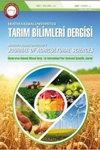The Factors Affecting Heavy Metal Levels in the Muscle Tissues of Whiting (Merlangius merlangus) and Red Mullet (Mullus barbatus)
IF 1.1
4区 农林科学
Tarim Bilimleri Dergisi-journal of Agricultural Sciences
Pub Date : 2016-08-25
DOI:10.1501/TARIMBIL_0000001393
引用次数: 9
Abstract
This study aims to determine heavy metal accumulation levels in the muscles tissues of two economically most important demersal fish species in the Eastern Black Sea, Turkey, red mullet (Mullus barbatus) and whiting (Merlangius merlangus), and evaluate the effects of fish species, sampling locations, fishing season and size groups on heavy metal accumulation levels. Chromium (Cr), manganese (Mn), cobalt (Co), nickel (Ni), copper (Cu), zinc (Zn), arsenic (As), cadmium (Cd) and lead (Pb) concentrations in fish muscle samples were measured with Inductively Coupled Plasma Mass Spectrometry (ICP-MS). Co, Zn, As and Cd accumulation levels in both species differed significantly (P<0.05). The metal concentrations of muscle tissues of both species, in general, were higher during summer and autumn. In the study, the differences in concentrations levels of As and Pb in whiting, Co, Cu, and Pb in red mullet muscle tissues were significantly related to fishing locations. The results of metal concentrations were compared with various legal limits such as Turkish Food Codex (TFC 2011), European Communities Commission Regulation (EC 2006) and Food and Agriculture Organization (FAO 1983) and the obtained metal levels of fish muscle tissues of both species were found to be below the limit values which are a threat to human health.影响白鲑和红鲻鱼肌肉组织中重金属含量的因素
本研究旨在确定黑海东部两种经济上最重要的底栖鱼类土耳其红鲻鱼(Mullus barbatus)和白鲑(Merlangius merlangus)肌肉组织中的重金属积累水平,并评估鱼类种类、采样地点、捕捞季节和体型组对重金属积累水平的影响。采用电感耦合等离子体质谱法(ICP-MS)测定了鱼肌肉样品中铬(Cr)、锰(Mn)、钴(Co)、镍(Ni)、铜(Cu)、锌(Zn)、砷(As)、镉(Cd)和铅(Pb)的浓度。两种植物Co、Zn、As和Cd积累水平差异显著(P<0.05)。两种动物肌肉组织中金属含量在夏季和秋季均较高。在研究中,红鲻鱼肌肉组织中As和Pb、Co、Cu和Pb的浓度水平差异与捕捞地点有显著相关。将金属浓度的结果与各种法律限制进行了比较,如土耳其食品法典(TFC 2011)、欧洲共同体委员会条例(EC 2006)和粮食及农业组织(FAO 1983),发现这两种鱼类肌肉组织中获得的金属含量均低于对人类健康构成威胁的极限值。
本文章由计算机程序翻译,如有差异,请以英文原文为准。
求助全文
约1分钟内获得全文
求助全文
来源期刊
CiteScore
1.40
自引率
0.00%
发文量
26
期刊介绍:
Journal of Agricultural Sciences (JAS) is an international, double-blind peer-reviewed, open-access journal, published by the Faculty of Agriculture, Ankara University. The journal invites original research papers containing new insight into any aspect of Agricultural Sciences that are not published or not being considered for publication elsewhere. Preliminary, confirmatory or inconclusive research, review articles, case and local studies and works presenting taxonomy will not be published.

 求助内容:
求助内容: 应助结果提醒方式:
应助结果提醒方式:


